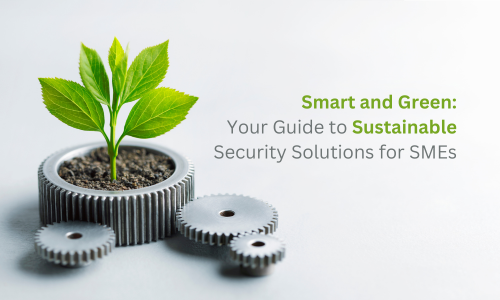By Jason Nisbet, Operations Manager, STFS
In my experience as a seasoned operations manager for a fire and security provider, I understand the pressing need for businesses, especially small and medium-sized enterprises (SMEs), to prioritise physical security. However, today’s security landscape demands not only effective measures but also sustainable practices that minimise environmental impact. Whether you’re a business owner, facilities manager or in another role with responsibility for company security, here’s how you can enhance physical security while promoting sustainability.
1. Evaluate Your Security Needs
Start with a comprehensive risk assessment of your premises. Identify vulnerabilities, assess your current security measures, and determine where improvements are needed. This step will help you prioritise investments in security technologies that offer the best protection without unnecessary expenditure. If it’s been sometime since an evaluation has been undertaken, if you’ve recently joined the businesses or been given responsibility, or you have or plan to move premises, investing in a thorough evaluation will ensure a more effective and sustainable security strategy.
2. Opt for Energy-Efficient Surveillance Systems
Modern surveillance systems have come a long way in terms of energy efficiency. Look for high-definition IP cameras that consume less power and have features like motion detection to reduce energy use when monitoring isn’t needed. Additionally, consider using solar-powered cameras for outdoor areas, which can significantly lower your carbon footprint.
3. Implement Smart Access Control
Replacing traditional locks with smart access control systems can enhance security while being eco-friendly. These systems often have features that allow for remote management and monitoring, which can reduce the need for physical keys and associated hardware. Moreover, they can be programmed to grant access only when necessary, conserving energy and resources.
4. Use Sustainable Materials
When upgrading or installing physical security features, consider using sustainable materials. For example, opt for fencing or barriers made from recycled materials. This not only reduces environmental impact but can also resonate positively with your clients and stakeholders, showcasing your commitment to sustainability.
5. Integrate Security Systems
An integrated approach to security allows for better management and reduces the need for multiple systems, minimising resource use. Combine your surveillance, access control, and alarm systems into one platform that can be monitored and managed efficiently. This integration can streamline operations and decrease energy consumption. Building management systems (BMS) can be integrated with access control systems to automate workflows and reduce energy waste. For example, BMS can adjust lighting, heating, or cooling based on occupancy information.
6. Train Employees on Sustainability Practices
Promote awareness among your staff about the importance of security and sustainability. Regular training sessions can help them understand how to use security systems efficiently, reducing the likelihood of unnecessary energy use or resource waste. A well-informed team is essential for maintaining a secure and sustainable workplace. Opt for paperless training and provide tailored, online learning which is focussed, engaging and brief, meeting teaching goals without draining resources in terms of paper and power consumption.
7. Regular Maintenance and Upgrades
Investing in regular maintenance of security systems ensures they operate efficiently, which can help reduce energy consumption. Additionally, staying up to date with the latest sustainable technologies can lead to improved security performance and lower environmental impact. Always dispose of old equipment in an environmentally responsible manner, recycling where possible.
8. Consider Remote Monitoring Services
Utilising remote monitoring services can greatly enhance security while being cost-effective and eco-friendly. By leveraging cloud-based solutions, SMEs can reduce the need for physical site visits, which in turn lowers fuel consumption and carbon emissions. Remote monitoring also enables rapid response to incidents without the need for extensive onsite resources.
To Sum Up
Securing your business doesn’t have to come at the expense of sustainability. By adopting energy-efficient technologies, using sustainable materials, and fostering a culture of awareness and responsibility, you can create a secure environment that aligns with environmental goals. As the importance of sustainability continues to grow, integrating these practices into your security strategy will not only protect your assets but also enhance your reputation as a responsible business leader.
If you have questions around your own fire and security set up, please get in-touch on 01224 573601 or at jason.nisbet@stfs.co.uk. I’m always happy to help.

